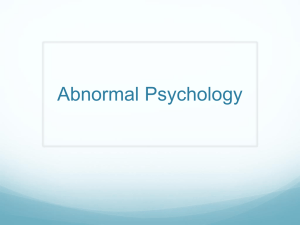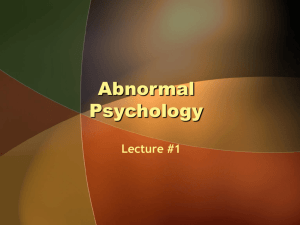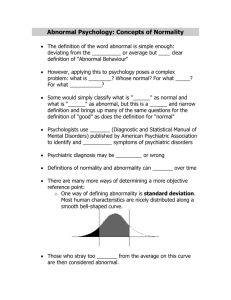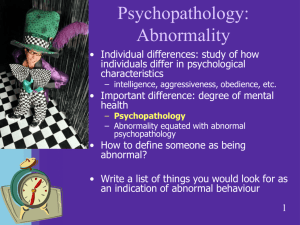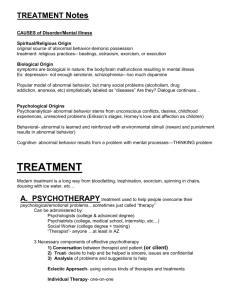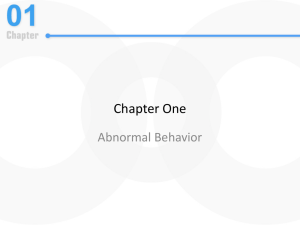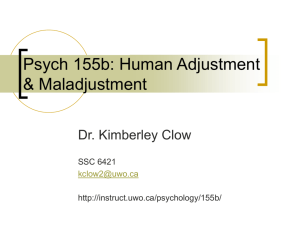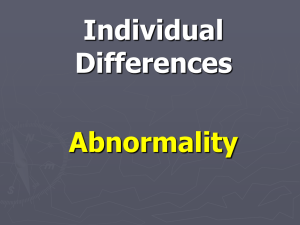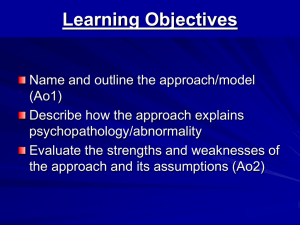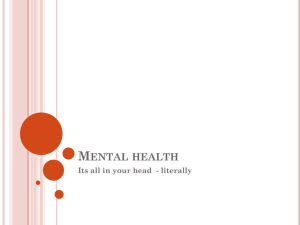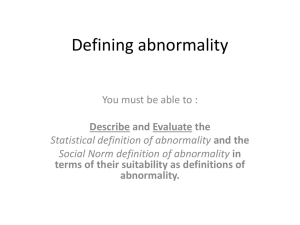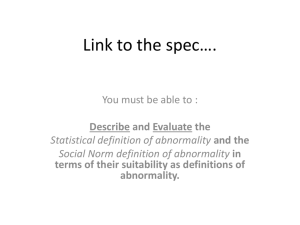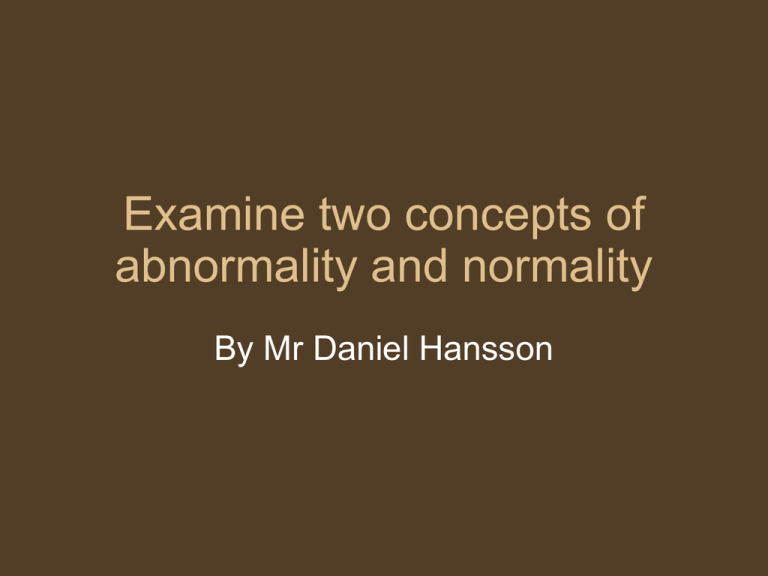
Examine two concepts of
abnormality and normality
By Mr Daniel Hansson
Questions for discussion
1. List all the psychological disorders that
you know. Try to figure out why they are
considered to be disorders
2. When can an individual be considered to
be insane?
3. Are H.M. and Clive Wearing abnormal?
Definitions
• Normality: Something that is the majority;
Being within certain limits that define the
range of normal functioning; Being able to
hold down a job, and is not a threat to
others or themselves.
• Abnormality: Not being in the norm; Not
being able to hold down a job, and/or is a
threat to themselves and others.
Characteristics of abnormality
•
•
•
•
•
•
•
Suffering
Maladaptiveness
Irrationality
Unpredictability and loss of control
Rareness and unconventionality
Observer discomfort
Violation of standards
Three aspects of abnormality
• Diagnosis
• The cause of the problem (etiology)
• Therapy to treat the problem (related to
the abnormality criterion)
Tests for psychological disorders
• www.4degreez.com/misc/personality_disor
der_test.mv
• www.gotoquiz.com/what_mental_disorder
_do_you_have
Two concepts of abnormality (and
normality)
• The mental illness criterion
• The social and cultural norms criterion
The mental illness criterion
• Normality depends upon a properly
functioning physiology and nervous
system and no genetic predispositions to
inherit mental disorder
Supporting evidence
• Studies on the relationship between physiology,
genetic make-up and abnormal behaviour (e.g.
Caspi 2003, Kendler 1991, Carraso 2000,
• The universality (etics) of some disorders (e.g.
eating disorders, depression and behaviours
associated with psychosis – e.g. delusions and
hallucinations)
• Sex differences in the prevalence of mental
illness (which may be due to physiological
differences between men and women)
• Many people voluntarily seek help because of
their problems
Challenging evidence
• Different countries have different tools for
diagnosis (e.g. DSM IV-TR in United
states, CCMD-3 in China)
• The existence of culture-bound syndromes
(emics)
• Cultural variations in the prevalence of
certain disorders
• Ethical issues: labeling, stigmatization
The social and cultural norms
criterion
•
•
•
•
•
•
Szaz (1960): Members of society that break social and cultural norms are
defined as abnormal (History of madness)
Scheff (1966): Labeling people as abnormal establish clear norms of reality
and appropriate behaviour (conformity)
Laing’s (1967) conspirational model: In order to keep their definition of
reality, the family, general practitioners and psychiatrists conspire against
the “insane” by imprisoning and degrading them as human beings
Social identity theory: People who are not included in the in-group are
defined as abnormal
Abnormal behaviour violates moral or ideal standards or differs from
commonly accepted beliefs or ways of thinking. It is a way to find a
dispositional cause of disruptive behaviour instead of situational factors
(fundamental attribution error). Instead of saying “evil”, “bad” or “crazy”, we
say “anti-social personality disorder” or “schizophrenia”.
What is abnormal in one culture (e.g. strange visions, speech and
behaviour) might be regarded as special or sacred in another culture (e.g.
shamanism)
Supporting evidence
• Different countries have different tools for diagnosis (e.g. DSM IVTR in United states, CCMD-3 in China)
• Homosexuality was considered to be abnormal until DSM-III (1980).
It is still considered abnormal in many countries.
• Unmarried mothers in Britain and political dissidents in the Soviet
unions were once confined to institutions for abnormality. The
tendency for American black slaves in the 1800s to try flee captivity
was considered to be a mental illness. It is claimed that psychiatry
also have been used to silence political dissidents in China (e.g. the
Falungong movement)
• The existence of culture-bound syndromes (emics)
• Gender differences in mental health (which may be due to
differences in social expectations)
• Cultural variations in the prevalence of certain disorders
Challenging evidence
• The universality (etics) of some disorders (e.g.
eating disorders, depression and behaviours
associated with psychosis – e.g. delusions and
hallucinations)
• Inuit tribes have linguistic distinctions between
“shaman” and “crazy people” in their society
(Murphy 1976)
• Many people voluntarily seek help because of
their problems
• Problems with supporting research (qualitative)

